The Flesch Reading Ease is a readability index that aims to measure how easy it is to read, or rather understand a text. In this article, we will see what are the different readability indexes used to analyze texts, what kind of information they give us and how much they matter in terms of SEO.
We’ll also see what the shortcomings of these types of tests are and why indexes have been developed to adapt to the different languages in which content is written. First, let’s see what parameters these analyses are based on.
Table of Contents
Readability Indexes
Typically, readability tests take into account a few key elements to determine a score.
These parameters may include the length of sentences, often counting the number of words, and the length of the words themselves, considering the length in letters or syllables. These text analysis criteria are used with mathematical formulas to obtain a readability index.
Each of these indices, therefore, takes into account specific criteria and above all is developed for a specific language.
The Flesch Reading Ease Index
The first readability test was developed by the American scholar Rudolf Flesch. Flesch proposed his method in 1948 by first using a scale from 0 to 100, and thus the Flesch Reading Ease index was developed.
Flesch’s formula takes into account two parameters to determine the difficulty of understanding a text:
- the average length of words, counting the number of syllables
- the average length of sentences, counting the number of words.
Using these two values in an equation gives a score between 0 and 100.

Where S equals the average word length, calculated from 100 words, and W equals the average sentence length.
To get S we will have to divide the total number of syllables by the number of words. Instead, we can obtain W by dividing the number of total words by the number of sentences.
The result will then be the readability index, but how do we interpret this score?
When the value obtained from the formula is near zero, the text is difficult to understand, while the simplest texts are those that obtain the results nearest to one hundred.
When the scores are compared to the educational/scholastic level, this match is obtained.
| Index | Scholastic level (USA) | Scholastic level | How to interpret the score |
|---|---|---|---|
| 100 – 90 | Fifth grade | Elementary school | Easy to understand for an eleven-year-old child |
| 90 – 80 | Sixth degree | Middle school | Easy to read, on par with a conversation |
| 80 – 70 | Seventh grade | Middle school | Fairly simple |
| 70 – 60 | Eighth and ninth degree | High school | Easy to understand for 13-15 year olds |
| 60 – 50 | Tenth to twelfth grade | High school | Fairly difficult |
| 50 – 30 | College | University | Difficult |
| 30 – 10 | College (upon graduation) | Graduate or Post-graduate | Very difficult |
| 10 – 10 | Professional | Graduate or Post-graduate | Extremely difficult |
Later Flesch together with Peter Kincaid updated the readability index to obtain a new formula called the Flesch-Kincaid index. With this new index, it is possible to directly obtain the level of education required for the comprehension of a given text. For this reason, the index is also called Flesch-Kincaid Grade Level.
Again, sentence length and word length are considered. The two parameters fit into this formula:

Where W is the average number of words per sentence, which is obtained by dividing the total number of words by the total number of sentences. S, on the other hand, represents the average number of syllables per word, which is the total number of syllables divided by the total number of words.
The Gunning Fog Index
A second index developed for the English language is the one introduced by Robert Gunning in 1952. Also in this case, the index is aimed at establishing the level of education needed to understand a given text.
- number of words
- number of sentences
- percentage of difficult words.
The following formula is obtained for the Gunning Fog index:

Where W/S is the ratio between the number of words and sentences, W/D is the ratio between difficult words and the total number of words.
This index, compared to the Flesch formula, introduces a new variable, taking into consideration the most complex words and distinguishing them from those of common use.
Difficult or complex words are considered all those composed of three or more syllables. Exceptions are compound words, verb conjugations and adverbs.
The score obtained ranges from 6, which is equivalent to the educational level of a student between 11 and 12 years old (sixth grade) to 17, which is the educational level of a college graduate.
The Flesch Reading Ease adaptation in other languages.
The formula as we have seen was structured in the English language, so in the years following its publication, there have been adaptations of the formula according to other languages.
For example the Kandel – Moles adaptation for French, the Fernandez – Huerta formula to adapt the index to Spanish and the Franchina – Vacca adaptation for Italian.
Among other languages, the Italian Flesch Reading Ease adaptation suggested in 1972 follows this formula:

Where S is the average number of syllables per word and P is the average number of words per sentence.
The Franchina – Vacca index was later modified in 1986 with this formula:

The adaptation comes from a test performed by Vacca on two versions of the same text in Italian and in English. Using the previous formula, the two texts showed different readability values. The formula was therefore modified to obtain a greater correspondence between the texts in the two languages.
The simplicity of use of the formula is reduced due to the hyphenation system and therefore the difficulty of counting syllables with an automatic calculation. For this reason, indexes that do not take syllables into account have also been developed.
An example is the GULPEASE index which uses the number of letters to measure the length of words
The GULPEASE Index
In 1988 the University Group of Linguistic Pedagogy also known as (Gruppo Universitario Lingustico Pedagogico) at La Sapienza University in Rome developed a test to evaluate the ease of comprehension of Italian texts, called the Gulpease.
The index was created with the purpose of making it easier to derive the test score through automatic calculation. For this reason, instead of evaluating the length of words in syllables, the number of letters is used.
In order to evaluate the reading ease of a text, two parameters are taken into consideration: the length of the words understood as the number of letters, and the length of the sentences. The values are entered into this formula:

The range of scores obtained from the formula can be interpreted according to the level of education by following these guidelines:
- a score lower than 80 is considered difficult for those who have an elementary license
- a score lower than 60 is considered difficult for those who have a middle school diploma
- a score of less than 40 is considered difficult for those with a high school diploma.
Measure the readability index of a text
To evaluate the readability of a text in addition to being able to use one of the formulas we have seen and calculate the index manually, you can also use tools that make the job easier for us.
In more detail, we’ll see how to get the readability index using text editors, online tools and WordPress plugins.
Statistics of Readability with Microsoft Word
The office package, especially Word, includes text readability statistics based on the Flesch Reading Ease score and the Flesch-Kincaid Grade Level score.
To activate the statistics you should enable the Show Readability Statistics option in the program’s settings. After that, you need to start the Spelling and Grammar Checker and have the text analyzed. You can select the tool from the top bar or by pressing F7.
After correcting (or ignoring) the errors, you will be shown a box like the one you see below with the text readability analysis.
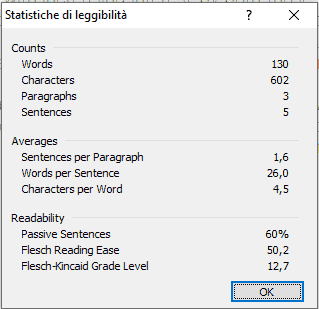
For English texts, as you see in the screenshot above, the Flesch Reading Ease and Flesch-Kincaid indexes are used.
The analysis of texts in other languages, such as texts in Italian on the other hand, shows us the Gunning Fog and Gulpease index.
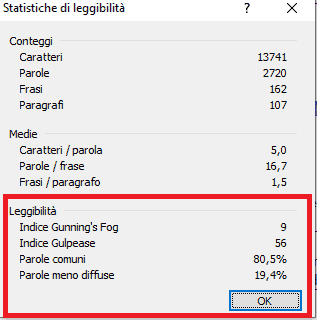
Online Readability Tools
To assess the readability directly online you can use the Gunning Fog index site.
Another useful tool is Readable by WebFX which allows you to calculate a readability score by copying and pasting text or test a web page directly by entering the URL.
The text will be analyzed according to multiple indices including Flesch Reading Ease, Flesch-Kincaid and Gunning Fog index. The analysis statistics will also be shown with the number of words, sentences and complex words.
Online readability calculation for other languages
Taking the Italian language as an example, on farfalla-project you can calculate the readability of a text by copying and pasting the text into the box as shown below. The Gulpease index is used for the analysis.
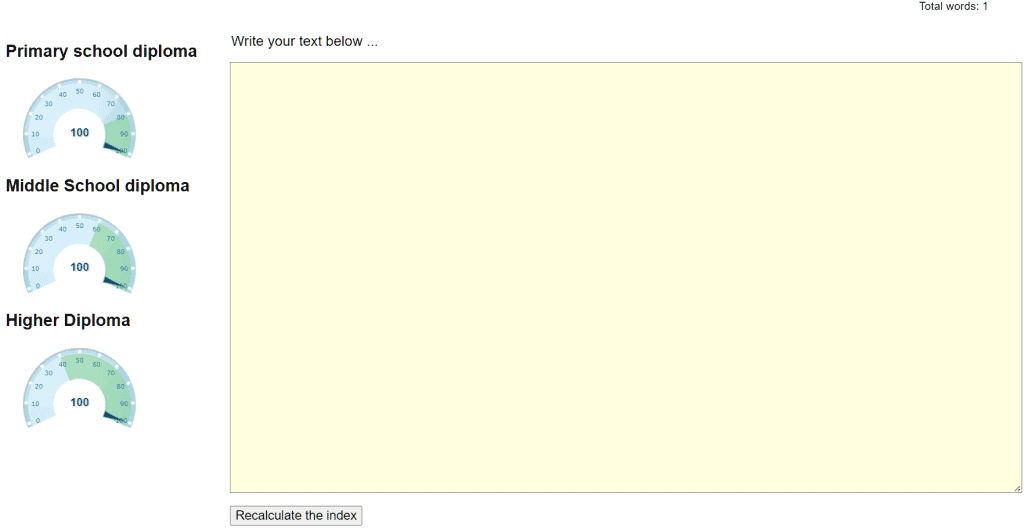
Yoast SEO and the Flesch Reading Ease score
Readability index scoring and in particular the Flesch Reading Ease score is often included in SEO tools. One such example is the Yoast SEO plugin that allows us to get readability scores of articles on WordPress.
Yoast SEO measures readability using the Flesch formula and gives back a result between 0 and 100. As we have seen, the higher the score obtained, the easier the text will be to read. In this example, a score greater than 60 is considered acceptable.
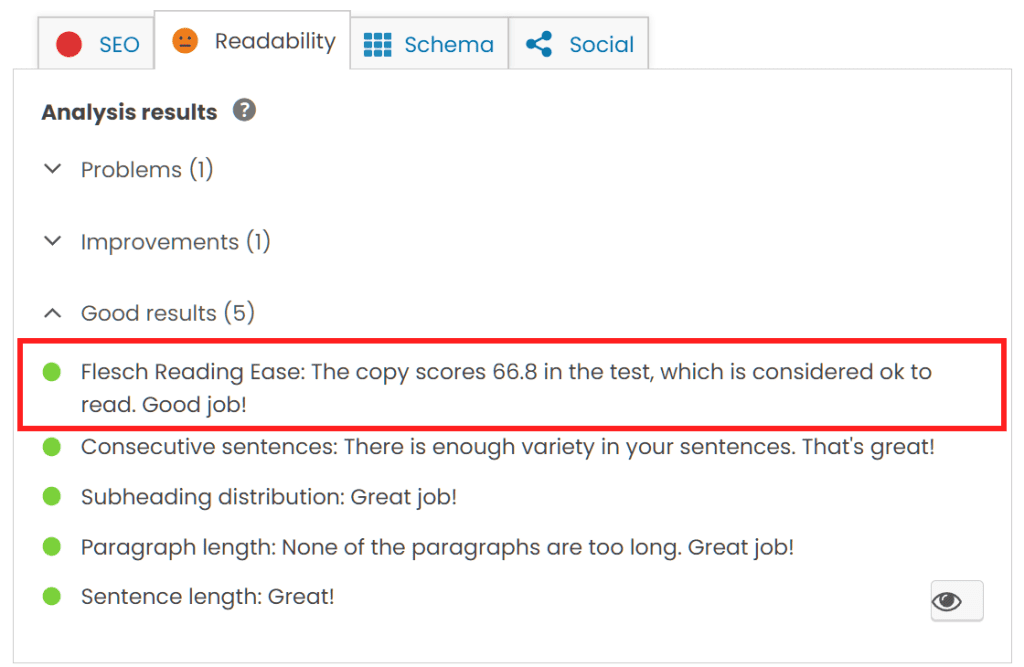
To help us understand at a glance the result, the plugin shows us not only the score but also a green light, yellow or red traffic light. As you can see in this example a score below 60 is considered fairly difficult to read and will therefore show an orange indicator.
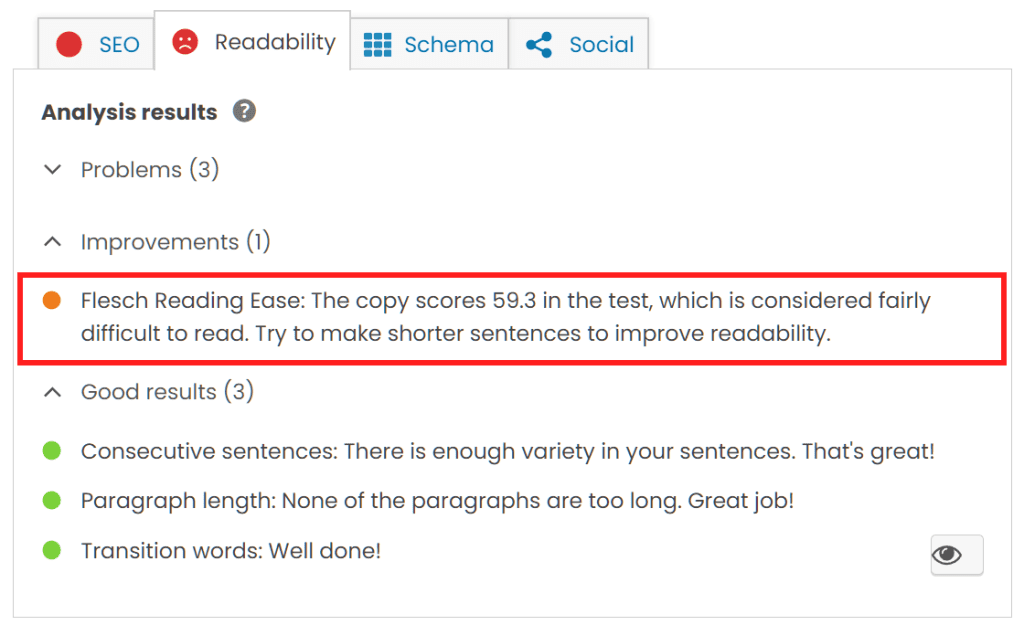
What else does Yoast SEO tell us about readability? In addition to giving us indications about the Flesch Reading Ease index, the plugin also gives us other indications that write a smoother article.
Actually, the analysis also checks the length of paragraphs and sentences and verifies that there are enough transition words. The distribution of subtitles (tag header) within the text and the variability of sentences is also taken into account. In particular, the tool makes sure that there are no consecutive sentences that start the same way.
But why should text readability be important for SEO?
Flesch Reading Ease and SEO
According to John Mueller’s claims, the algorithm used for ranking on Google does not include readability scores. This means that the high readability index of a text will not have a direct impact on SEO.
Why then focus so much on making articles more understandable? For the same reason that the content of your pages is important for SEO analysis of your site.
What you need to consider is that Google always cares about the user experience and as a result, your content should also be written with your target audience in mind.
Therefore, rather than focusing on readability scores in absolute value, you should try to figure out if your content is easy enough to read for your audience.
You just need to start with a simple consideration: if your readers don’t understand what you’ve written, they’ll look for the same information on another site, hopelessly abandoning yours. And remember that the amount of time the users stay on your site is an important factor.
Conclusion
In this article, Flesch Reading Ease and other readability indexes, we have seen how the Flesch Reading Ease index is used to analyze the readability level of content. It is one of the most widely used readability indexes and is also used by on-page SEO tools like Yoast SEO. Alongside the Flesch formula, there are also other indexes designed for other languages such as English and Italian, as well as formulas adapted to work with Italian.
Did you already know the utility of readability indexes? How much weight do you give to readability indexes provided by SEO tools on the content you publish? Let me know with in the comments below.





Leave a Reply